
In evolutionary ecology, a parasitoid is an organism that lives in close association with its host at the host's expense, eventually resulting in the death of the host. Parasitoidism is one of six major evolutionary strategies within parasitism, distinguished by the fatal prognosis for the host, which makes the strategy close to predation.

The Braconidae are a family of parasitoid wasps. After the closely related Ichneumonidae, braconids make up the second-largest family in the order Hymenoptera, with about 17,000 recognized species and many thousands more undescribed. One analysis estimated a total between 30,000 and 50,000, and another provided a narrower estimate between 42,000 and 43,000 species.

Eupackardia is a monotypic moth genus in the family Saturniidae erected by Theodore Dru Alison Cockerell in 1912. Its only species, Eupackardia calleta, the calleta silkmoth, was described by John O. Westwood in 1853. It is found in Mexico, Guatemala, as well as in the states such as; Arizona, New Mexico, and Texas.

Megarhyssa macrurus, also known as the long-tailed giant ichneumonid wasp or long-tailed giant ichneumon wasp, is a species of large ichneumon wasp. It is a parasitoid, notable for its extremely long ovipositor which it uses to deposit an egg into a tunnel in dead wood bored by its host, the larva of a similarly large species of horntail.
Nemoria rubrifrontaria, the red-fronted emerald, is a species of moth in the family Geometridae, in the superfamily Geometroidea. The species was described by Alpheus Spring Packard in 1873. It is found in North America.
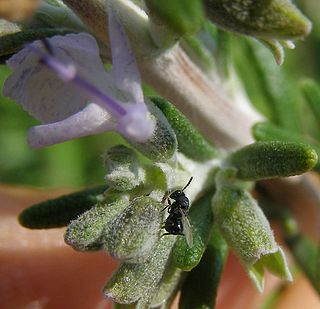
Eurytoma is a genus of parasitoid chalcid wasps in the family Eurytomidae. There are at least 620 described species in Eurytoma.

Alabagrus texanus is a species of braconid wasp in the family Braconidae. It develops within the larvae of Herpetogramma theseusalis. Males emerge from pupation earlier than females. Females typically only mate once, whereas males mate more than once.
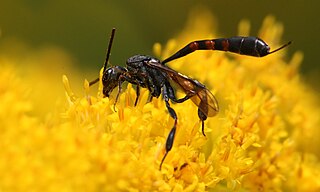
Gasteruption assectator, the wild carrot wasp, is a species of carrot wasp in the family Gasteruptiidae. It is found in the Czech Republic, Slovakia, and Hungary. G. assectator is a generalist inquiline parasitoid of many other bee and wasp species such as Hylaeus confusus, Hylaeus pectoralis, and Pemphredon fabricii.

Labena grallator is a species of ichneumon wasp in the family Ichneumonidae. It is a parasitoid of wood-boring beetle larvae, including Chrysobothris femorata larvae as well as Callidiellum rufipenne pupae.

Minotetrastichus frontalis is a species of chalcid wasp in the family Eulophidae. It is a parasitoid of Phyllonorycter moths, with larvae capable of feeding on both larval and pupal stages of the moth. M. frontalis has four larval stages and three molts, with development lasting eleven days.

Oebalus ypsilongriseus is a species of stink bug in the family Pentatomidae. It is native to South America, where it is known to feed on rice crops, as well as cotton, barley, oat, and wheat.
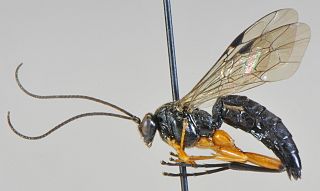
Pimpla pedalis is a species of ichneumon wasp in the family Ichneumonidae. The species is a pupal parasitoid of Iridopsis ephyraria.

Pimpla turionellae is a species of ichneumon wasp in the family Ichneumonidae. Its host is the larvae and pupae of Galleria mellonella

Pseudochalcura gibbosa is a species of chalcid wasp in the family Eucharitidae. It is associated with ants from the Camponotus genus.

Rhyssinae is a subfamily of parasitoid wasps in the family Ichneumonidae. It contains eight genera and 259 described species, but there are likely many undiscovered species.

Sphelodon phoxopteridis is a species of parasitoid wasp in the family Ichneumonidae.
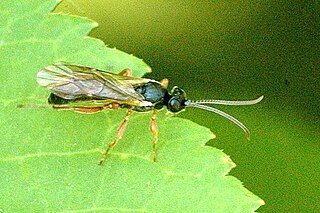
Triclistus pallipes is a species of ichneumon wasp in the family Ichneumonidae. It is a parasitoid of Epermenia chaerophyllella larvae and Swammerdamia pyrella cocoons
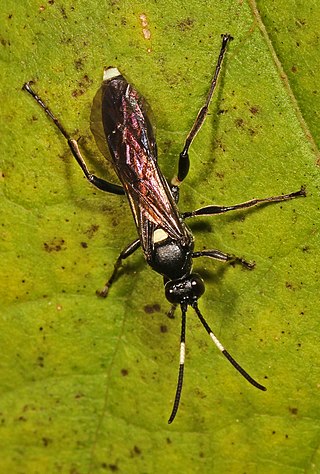
Vulgichneumon is a genus of ichneumon wasps in the family Ichneumonidae. There are at least 30 described species in Vulgichneumon.
Aulacus burquei is a species of parasitoid wasp in the family Aulacidae. It is found in North America. It's only known host is Xiphydria. A. burquei lays its egg within the eggs of its host.

Diastrophus nebulosus is a species that forms galls. Its common name is the blackberry knot gall wasp. Its host plant is Rubus flagellaris.



















